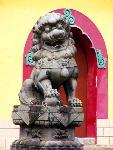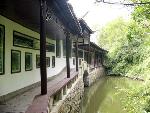- Getting around Lijiang. Dont stay in the Old Towns more than 2 days, there is nothing to do. KRISS Oct 9, 2013 05:46
- 2013 Beijing Temple Fair BENNYLAU Feb 26, 2013 03:29
- Malaysian traveling from KUL - LAX vis Shanghai PVG ZATI_DY Jan 3, 2013 20:15
Temples in Hidden Places
- Views: 7476
- |Vote: 2 0
- |Add to Favorites
- |Recommend to Friends
Youmin Si
Nanchang's not a common destination for travellers in China, neither domestic nor foreign. It receives some attention for its revolutionary history and for the Tengwang Pavillion that stands on the shores of the great Gan River, but aside from that, it is largely left alone. Part of the reason is that the city appears a little bleak - that being, its history is not particularly extensive and the architecture is plain and functional, so it is occasionally considered to be charmless.
Even so, there are often pearls to be found in many places where others do not care to look, and in the case of a provincial capital such as Nanchang, I was certain there had to be some remarkable nooks and crannies filled with treasures for curious travellers. A brief survey of the local map and some checking of guide materials revealed that Nanchang was certainly host to a number of lesser-known treats.
The first I decided to check out was right across the road from the peaceful Bayi park where I'd been watching out for evidence of the city's revolutionary past the day before. The small but enchanting Youmin Temple suffered for that - its proximity to the uprising masses - during the cultural revolution. China's Red Guard, made up of Chinese youth mobilised by the central government to refocus the party's revolutionary drive against the capitalist classes and the superstitions of old regimes, turned on the temple and levelled it in the sixties. In more recent times, the party has been said to regret the overenthusiastic destruction of historically significant cultural assets, and places like Youmin Temple have been getting some attention and being restored at last. Construction work on Youmin Temple is now complete and the prayer rooms resound again with the mellow chanting of resident monks.
Admission to the temple is a mere two yuan and it is a thoroughly delightful place to see. Its 1995 reconstruction has made the temple clean and colourful - laid out in bright yellows and reds - unusual colours for this kind of temple - its fresh design brings it a charm that other areas of Nanchang lack. It's a fully active temple, unlike many temples in China that are merely historical and made museums of - I saw plenty of monks wandering around the courtyards, and I also saw a number of locals taking their worship very seriously. One young woman held a handful of incense and stood before the altar before one of the large halls - she bowed to the Buddha, and then again in every direction, making elaborate movements and speaking out prayers as she did so.
The temple was built in 503AD and was made distinguished during its long history by a Buddhist Master known as Mazhu who lived during the Tang dynasty, and for a huge column made of copper, which earnt for it the resentment of the poor who wondered why so much valuable metal was standing uselessly in the temple. Nowadays, the temple adornments are far more affordable, and the temple boasts some dramatic and impressive Buddhas - one in particular stands huge in the central hall - although visitors should remember that it's considered offensive to photograph an enshrined Buddha.
Being reasonably familiar with temples, I was delighted by the the variations in design that this temple exhibited - although remaining in keep with the traditional Han standards that you'll see in ancient temples across the country, paralleled in Beijing's Forbidden City Palace Museum itself.
Shengjin Tower
Much closer to the train station in Xihu District stands the Shengjin Tower amidst a veritable warren of side streets that become increasingly daintified - although no more well-kept - the closer you get to it. The lanes around the tower seem ancient in themselves, decked in stone and busy with merchants and pedestrians swilling about in lively activity. Standing above the glorious mess at what was once the outer wall of ancient Nanchang, the tower is bright white and encircled with many bells that tinkle prettily above the crowds, creating an otherworldly soundtrack for the commerce below.
The story of the Shengjin Tower is a good one for those who like stories about buried treasure, because its construction in the Tang Dynasty in about 905AD relates to the story of a mysterious chest of valuables that was dug up on the site. The site had been selected and was being excavated in preparation for the building of the tower when the constructors' digging implements struck a large box made of solid iron. Upon opening the box, it was discovered to contain three ancient swords (each with its own name: the Riding WInd, the Fire Needle, and the Grand Dragon), over 300 Buddhist relics, and four bundles of rope - made out of pure gold. It was presumed that the site for tower had been auspiciously chosen indeed, and the tower was subsequently named Shengjin - which means, 'gold rope'.
Entrance to the tower complex is RMB10 and this price allows you to climb the tower as well as wander through the spacious courtyard and buildings below, an impressive one amongst them being a great stage built in traditional style where performances are sometimes held. I had a quick look around below before heading up the stairs. The tower is constructed in an octagonal shape and its interior is largely undecorated. The stairs to the top at 58.7m above ground level are extremely narrow - a comfortable pair of shoes is necessary to ensure balance for the seven story climb. An eighth level is inaccessible and is capped by a golden tripod, making the tower the tallest ancient building in the city. At each level, four windows face every direction, allowing for an increasingly comprehensive perspective of the city as you gradually ascend. And the view from the top is indeed worth the climb - It was at the top of the tower that I saw at last the scope of Nanchang, which I had hitherto thought of as a rather dull place - from above, as with all major cities, the magnificence of the sprawling human array was evident at last.
Home of the Drunken Artist
Sometimes the best part of travel is unexpected, and so it was when the bus I was taking took an unexpected turn, forcing me to get off and find my way to my destination - the Bada Shanren Memorial Museum - on foot. I'd kept a close eye on the map the whole journey and so knew exactly where I was, howver the location of the museum was a little less clearly marked albeit clearly not very far away.
It was a far cooler day than I'd endured during my stay in Nanchang the days previous, and so I delighted in wandering along the tree-lined avenues in the warm air, watching the activity of the locals as they went about their business. This anonymous suburb of a nondescript provincial capital was alive with ordinary human endeavour - my own momentary appearance in the lives of the locals was random and unnoteworthy, and it made me feel quite at home on Earth to be just one person wandering through a human dwelling, free to turn whichever corner I wished. It's that feeling that every traveller hopes for whether consciously or not, and I'm grateful that it has become characteristic of my existence in China.
I walked past the museum, although I had stopped to admire it without realising what it was. The Bada Shanren museum was once a thousand year-old temple called Qingyunpu before the artist moved there in 1661.
His real name was Zhu Da, and he was a 10th generation descendant of Zhu Yuanzhang, the first emperor of the Ming Dynasty. He proved to be an artistic genius - and a notorious drunkard - early in his life. His exceptional freehand brush style brought an uncommon edge to his traditional Chinese painting technique, and he became known as an artistic prodigy as a result. Looking back, he appears to be one of those rare geniuses whose addiction to drink gave him that highly sought-after touch of individuality evident in his artistic work - an element that carries a note of slight insanity. As I wandered through his works on display in the museum, I could almost see it - the unexpected emotional touches in the expressions on the faces of his human figures, and the almost cartoon-esque looks in the eyes of his animal subjects. Birds glare at each other in annoyance, a cat looks up with obvious self-content, and an old man smiles with unabashed enjoyment as he stands in the candlelight watching his friends share a drink together.
The pretty museum at the shore of a channel of a small lake is perhaps the most relaxing place in all of Nanchang. Visitors can sit along a willow-lined walkway and admire Bada Shanren's engravings in their frames, or wander beneath the trees in the ancient temple courtyard lit amber in the sunlight, stepping in to small alcoves where brushworks hang quietly on display, telling of the wild mind that once occupied these halls. Here is the otherwise plain city of Nanchang vindicated, for this is one corner of the place that is without reservation worth coming a long way to see.






 Copyright © 1998-2025 All rights reserved.
Copyright © 1998-2025 All rights reserved.
1.
Jul 16, 2009 00:46 Reply
JIANGNAN856 said:
On the Badashanren 'museum':
Just wanted to point out that there are no original Badashanren paintings in the museum- they are all copies, and pretty dirty, dust-covered ones at that. The newly- constructed park (still under construction) around the museum is pleasant enough, if the weather's good, but unless you're just interested in the site, I would just buy a good Badashanren book, rather then pay the (I thought rather steep) 20 yuan entrance fee to this place, to look at dusty dimly-lit copies and faded photos.
2.
Sep 17, 2006 23:18 Reply
CHYNAGYRL said:
Interestingly, drinking and writing poetry/music go together in Chinese culture. Do you listen to Gu Ching music? My friend was playing a song for me tonite on her gu ching, and it was written by a nobleman who drank straight for 40 nights as a kind of protest against the emperor. The emperor wanted to betroth his daughter and the nobleman's son, but the nobleman detested this emperor. So he drank himself silly, played gu-ching, and the emperor got the idea.